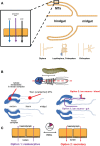Voltage-gated ion channels as novel regulators of epithelial ion transport in the osmoregulatory organs of insects
- PMID: 38835480
- PMCID: PMC11148248
- DOI: 10.3389/finsc.2024.1385895
Voltage-gated ion channels as novel regulators of epithelial ion transport in the osmoregulatory organs of insects
Abstract
Voltage-gated ion channels (VGICs) respond to changes in membrane potential (Vm) and typically exhibit fast kinetic properties. They play an important role in signal detection and propagation in excitable tissues. In contrast, the role of VGICs in non-excitable tissues like epithelia is less studied and less clear. Studies in epithelia of vertebrates and invertebrates demonstrate wide expression of VGICs in epithelia of animals. Recently, VGICs have emerged as regulators of ion transport in the Malpighian tubules (MTs) and other osmoregulatory organs of insects. This mini-review aims to concisely summarize which VGICs have been implicated in the regulation of ion transport in the osmoregulatory epithelia of insects to date, and highlight select groups for further study. We have also speculated on the roles VGICs may potentially play in regulating processes connected directly to ion transport in insects (e.g., acid-base balance, desiccation, thermal tolerance). This review is not meant to be exhaustive but should rather serve as a thought-provoking collection of select existing highlights on VGICs, and to emphasize how understudied this mechanism of ion transport regulation is in insect epithelia.
Keywords: Malpighian tubules; excretion; ion transport; salt and water balance; voltage-gated ion channels.
Copyright © 2024 Dates and Kolosov.
Conflict of interest statement
The authors declare that the research was conducted in the absence of any commercial or financial relationships that could be construed as a potential conflict of interest.
Figures

Similar articles
-
Voltage-gated ion channels are expressed in the Malpighian tubules and anal papillae of the yellow fever mosquito (Aedes aegypti), and may regulate ion transport during salt and water imbalance.J Exp Biol. 2024 Feb 1;227(3):jeb246486. doi: 10.1242/jeb.246486. Epub 2024 Feb 8. J Exp Biol. 2024. PMID: 38197515 Free PMC article.
-
Ventricular voltage-gated ion channels: Detection, characteristics, mechanisms, and drug safety evaluation.Clin Transl Med. 2021 Oct;11(10):e530. doi: 10.1002/ctm2.530. Clin Transl Med. 2021. PMID: 34709746 Free PMC article. Review.
-
Voltage-gated calcium channels regulate K+ transport in the Malpighian tubules of the larval cabbage looper, Trichoplusia ni.J Insect Physiol. 2021 May-Jun;131:104230. doi: 10.1016/j.jinsphys.2021.104230. Epub 2021 Mar 23. J Insect Physiol. 2021. PMID: 33766540
-
Novel mechanisms of epithelial ion transport: insights from the cryptonephridial system of lepidopteran larvae.Curr Opin Insect Sci. 2021 Oct;47:53-61. doi: 10.1016/j.cois.2021.04.001. Epub 2021 Apr 15. Curr Opin Insect Sci. 2021. PMID: 33866042 Review.
-
Computational Approaches to Studying Voltage-Gated Ion Channel Modulation by General Anesthetics.Methods Enzymol. 2018;602:25-59. doi: 10.1016/bs.mie.2018.01.002. Epub 2018 Mar 19. Methods Enzymol. 2018. PMID: 29588033
Cited by
-
Voltage-gated ion channel TRP/Painless regulates the excretory function of the Malpighian tubules in larval lepidopterans.J Exp Biol. 2025 Jun 15;228(12):jeb250084. doi: 10.1242/jeb.250084. Epub 2025 Jun 13. J Exp Biol. 2025. PMID: 40421706
-
The Biological Consequences of the Knockout of Genes Involved in the Synthesis and Metabolism of H2S in Drosophila melanogaster.Antioxidants (Basel). 2025 Jun 6;14(6):693. doi: 10.3390/antiox14060693. Antioxidants (Basel). 2025. PMID: 40563325 Free PMC article.
References
-
- Berenbaum M. Adaptive significance of midgut pH in larval Lepidoptera. Am Nat. (1980) 115:138–46. doi: 10.1086/283551 - DOI
-
- Wang C-Y, Bong L-J, Neoh K-B. Adult paederus fuscipes (Coleoptera: staphylinidae) beetles overcome water loss with increased total body water content, energy metabolite storage, and reduced cuticular permeability: age, sex-specific, and mating status effects on desiccation. Environ Entomology. (2019) 48:911–22. doi: 10.1093/ee/nvz065 - DOI - PubMed
Publication types
LinkOut - more resources
Full Text Sources

